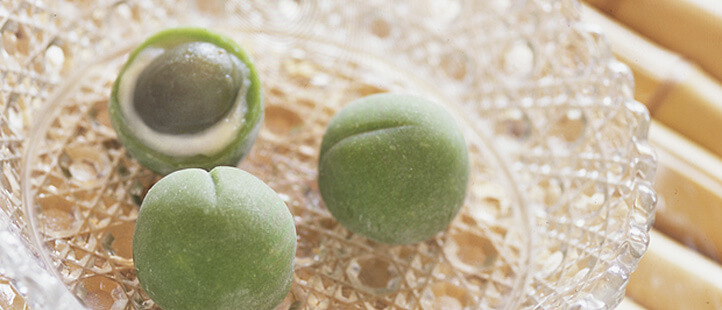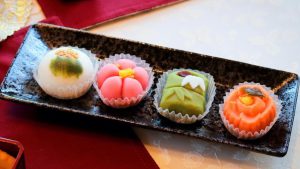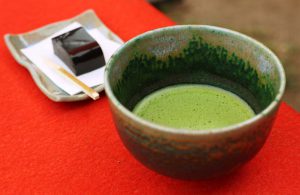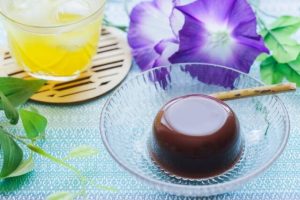Speaking of June, it’s the rainy season. The actual duration of the rainy season varies depending on the year and region, and in fact, the rainy season in July can be longer. However, the strong image of the rainy season is still associated with June.
As the temperature and humidity rise during this season, the world of Japanese sweets introduces confections made from summer ingredients such as kudzu and agar. Yet, the colors and overall style are still different from those of typical summer sweets, appearing more subdued and delicate.
Since the rainy season lasts only about a month, it’s essential to savor the seasonal feeling. Let me introduce the sweets for June.
Wakayu (Young Sweetfish)
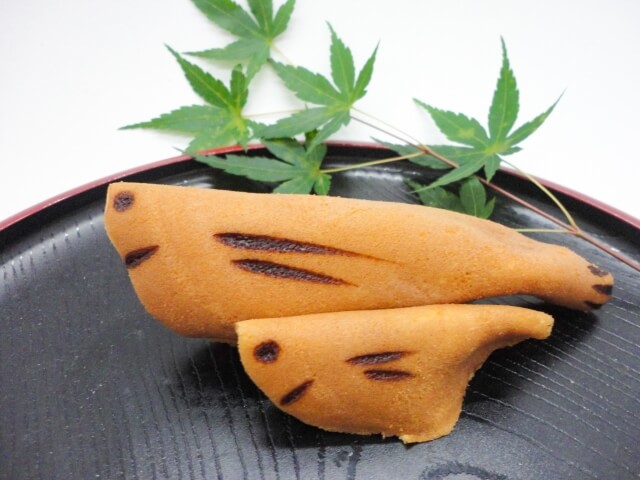
Wakayu, also known as “kougyo,” represents the summer ingredients in Japanese cuisine, particularly used in the summer season. Although the peak season for consuming sweetfish as a meal might be around July, the National Association of Sweetfish Aquaculture Fisheries set June 1st as the Sweetfish Day. Many regions and rivers lift the fishing ban on sweetfish on this day, which is why this fish-shaped sweet “Wakayu” is made.
Using a dough made from wheat flour and eggs, the sweet is baked into a long and oval shape, with sweet bean paste sandwiched inside, and then folded in half. The folding line represents the back of the sweetfish, so it’s designed to have the folding line on the opposite side, with eyes and gills drawn using a baking stamp.
When presenting the sweet, the head should be placed on the left and the tail on the right, just like how a meal is served. Some shops even incorporate weaving techniques to create a slender shape on the right side, expressing the elegant form towards the tail, making it intriguing to observe the craftsmanship.
The filling may also include gyuhi (a type of soft, mochi-like sweet) along with sweet bean paste, and various shops offer their unique touches.
Wakayu is generally larger compared to regular main sweets, and you may not find it in formal tea ceremonies. However, it is a popular, cute, substantial sweet with a gentle and fluffy taste that appeals to children and suits various tastes. Since many of them have a relatively long shelf life, they are also suitable as souvenirs.
Ao-ume (Green Plum)
The word “Tsuyu” (rainy season) is derived from the rain that falls during the season of plums. When June arrives, it’s time to harvest plums. Making plum wine, known as “umeshigoto,” is also a seasonal activity during this time. Among the various colors of plums, the unripe green plum is beloved as a design motif in sweets. Though you cannot eat actual green plums, it’s easy to understand the desire to express their refreshing appearance and fragrance in confections.
The sweet “Ao-ume” replicates a gathering of plums using light green-dyed gyuhi or uirou (a type of chewy sweet) dough, wrapping white sweet bean paste inside, and shaping it into small cubes (cuboids) with lines and dents, just like unripe plums.
White sweet bean paste is used for the filling to avoid interfering with the dough’s color. Many sweets also have plum flavor or mix plum flesh into the paste to enhance the taste and aroma of plums.
Even so, the plum flavor is just subtle enough not to overpower the sweet, making it suitable for those who are not fond of sour tastes.
In the world of traditional Japanese sweets, it is common to prefer indirect expressions rather than precisely replicating natural objects. The sweets that come close to real appearance, size, and taste are considered quite rare.
Some shops start making “Ao-ume” as early as May, but for tea ceremonies, it’s recommended to have them until early June to emphasize the seasonal atmosphere.
Ajisai, Yohira (Hydrangea)
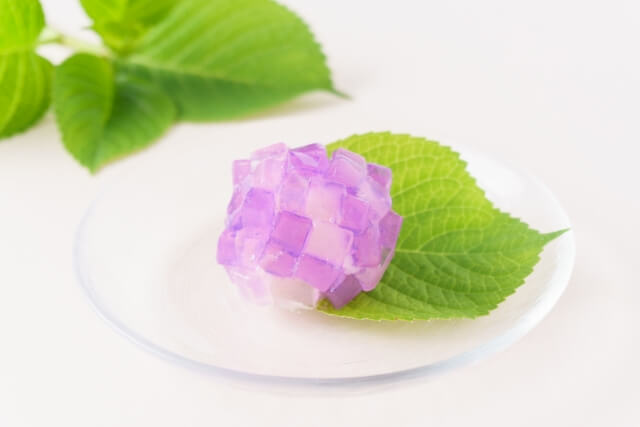
When it comes to symbols of the rainy season, hydrangea flowers are most representative. Formally known as “Gakuajisai,” they come in various shades of blue, purple, and white. The part that looks like flowers is actually the sepal (calyx), while the tiny bead-like structures at the center are the actual flowers.
As one of the seasonal flowers with a relatively short period of use, it strongly conveys the feeling of the rainy season.
The sweet “Yohira” (another name for hydrangea) precisely captures the appearance of hydrangea flowers using blue or purple agar. The name “Yohira” is derived from the four sepals of hydrangea flowers. In the world of Japanese sweets, “Yohira” is often used as a confection name.
White sweet bean paste is shaped into small cubes, a few millimeters on each side (cube shape), and covered with agar dyed in light green. The final appearance represents hydrangea flowers perfectly. The sparkly appearance of agar adds a refreshing touch and makes it a delightful sweet to enjoy during the humid season, alleviating the discomfort of the damp weather.
Hydrangea plants are relatively common, and if you can get your hands on them, serving “Yohira” with actual hydrangea leaves adds an elegant touch.
Minazuki
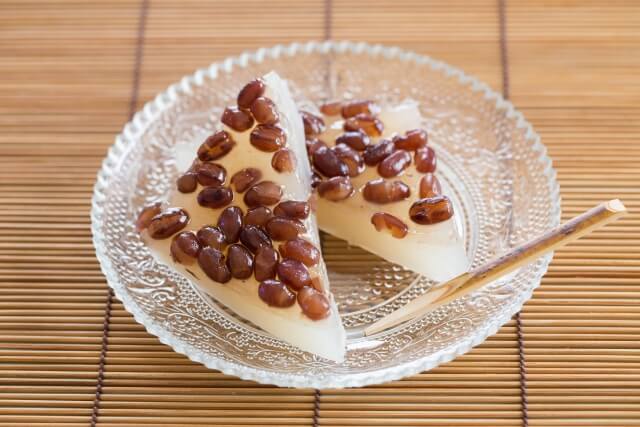
June 30th is the day for “Nagoshi no Harae,” an event that dates back to the Heian period in the imperial court. Even today, people pass through a circle made of miscanthus grass or float the “Katashiro” (representative paper dolls) down the river, cleansing away impurities accumulated over the past half-year and praying for a safe second half of the year.
The sweet “Minazuki” is associated with this Nagoshi no Harae, making it a representative sweet for June.
Minazuki consists of white bean paste sprinkled over the surface of the dough and then cut into triangular shapes (right-angled isosceles triangles). While they might all appear the same, there are differences among shops; some use kudzu for the dough, while others use black sugar for a richer flavor. Also, the amount of sweet bean paste may vary, with some shops covering the dough so thickly that it hides the dough entirely. Personally, I prefer those made with kudzu dough for their refreshing taste.
The custom of consuming wheat-made mochi during Nagoshi no Harae can be traced back to the Muromachi period. The present form of Minazuki was established during the Showa period when Kyoto’s sweet shops began making it for citizens to enjoy as a charm for warding off the summer heat on June 30th. Minazuki shares a similar story with Valentine’s Day chocolates, both being promoted by the confectionery industry (Japanese confectionery industry).
Although Nagoshi no Harae is observed on June 30th, Minazuki starts appearing in shops around mid-June.
